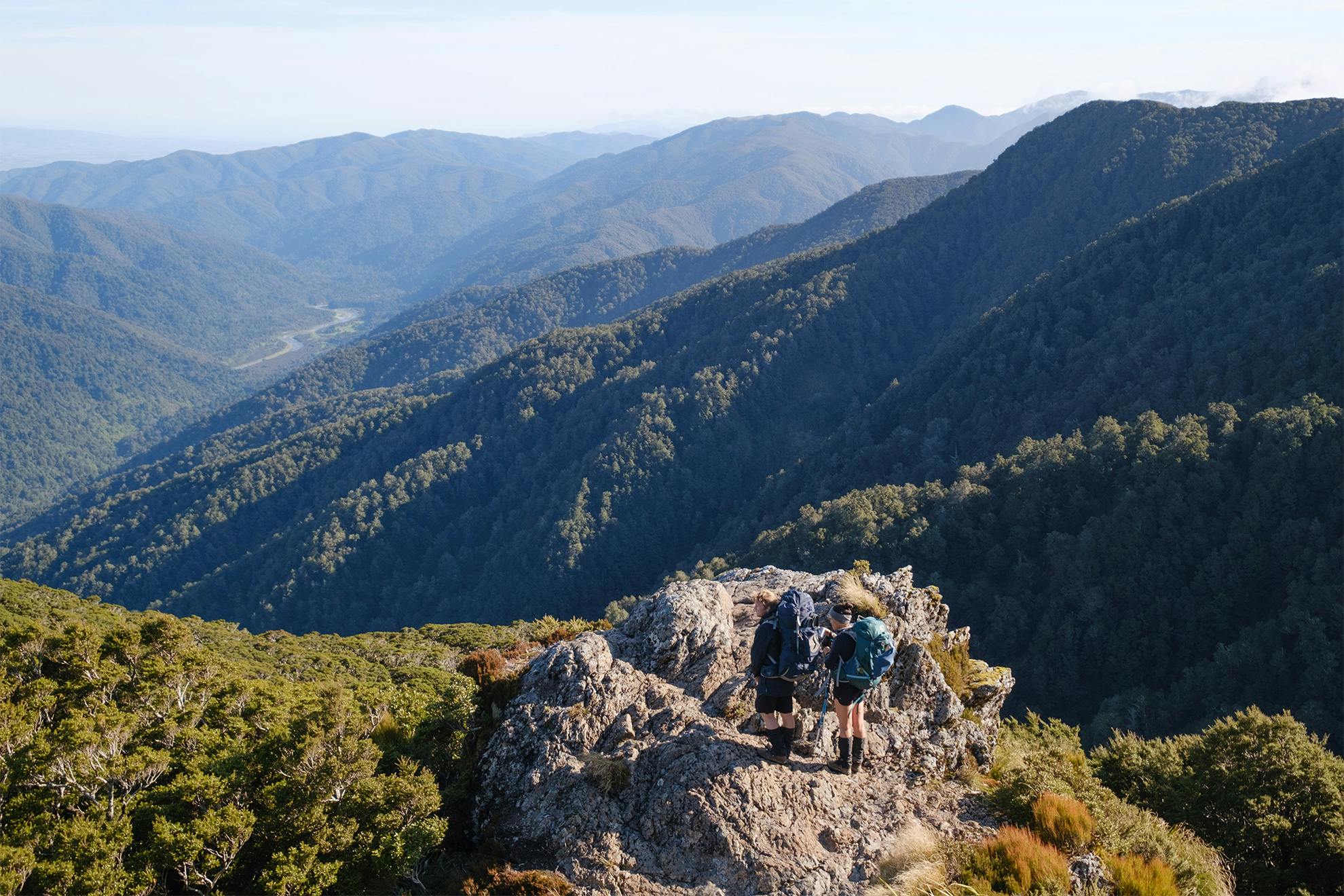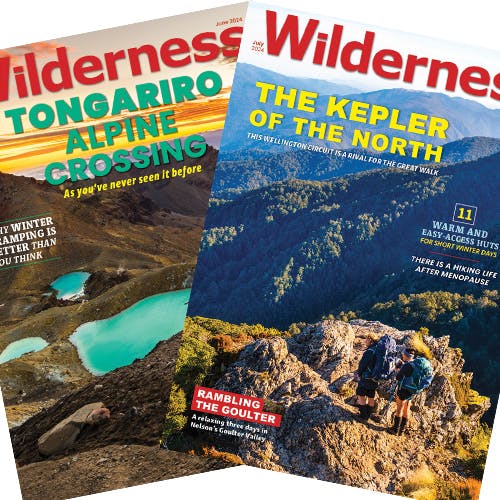Like Wellington city, the Holdsworth–Jumbo Circuit is hard to beat on a good day.
“Eighty days!” The words started as a warning and mellowed into a mantra of gratitude. Much has been written of Tararua’s weather, but a DOC sign at Mt Holdsworth Road end spells it out starkly. The tops experience just 80 clear days a year. I am forever grateful that I experienced three of them on my first visit to the notorious range.
The reputation of Tararua tramping has long kept me from making a date with it in my calendar. So far from my home in Auckland, and with the odds of a joyless, viewless trudge firmly stacked against trampers, it was never in my plans. However, a few days of fine spring weather presented a rare opportunity to tick it off, so with three others I made the long drive south.
We nipped to the supermarket in Masterton, then drove 20 minutes to the road-end car park, the distant mountains growing before us. It was a relief to step into old forest where every square inch supports a diversity of life.
On this trip was Robert Venell, author of The Forgotten Forest which details Aotearoa’s diverse fungi. Unsurprisingly, and minutes from the start, he fishes out a brilliant lichen from the undergrowth. Green on one side, yellow on the other and as big as a dinner plate, it was the first of many details Rob noted with his keen eye.

The Gentle Annie Track begins pleasantly, as its name promises – an easy climb through moss-carpeted podocarp forest. Shimmering fields of raurenga kidney fern cling to banks and trunks. A boisterous breeze billowed over the canopy, warning against complacency in the warm weather.
From Rocky Lookout, and with the help of the topo map, we anticipate the afternoon’s climb and our destination, Powell Hut, perched precariously 600m above.
A gentle climb of around 3km leads to Mountain House Shelter where we enjoy a short break. Built by Wellington Tramping and Mountaineering Club, it would be a real comfort to trampers in dogged weather. From there the well-graded track climbs urgently past shivering fern fronds and moss-clothed trunks, and I’m reminded of the ascent to Luxmore Hut on the Kepler Track. We sense we are nearing the bushline an hour later when remnants of a snow storm two days earlier appear.
At the bushline is a rocky outcrop, perfectly situated for the vista. It’s blowing but views over Tōtara Flats and the winding Waiohine River are brilliant. Powell Hut is a short, steep climb from here, and we arrive to find a deteriorating snowman on its deck.

The Great Walks-standard Powell Hut (32 bunks) is magnificent. Its deck overlooks the rolling foothills of the range, the twinkling lights of Masterton and the distant humps of Ngāumu Forest to the east. It’s busy but spacious, and we make ourselves at home. Our feet are soon itching, however, and we step out to explore beyond the hut.
Golden hour is upon us, but to the south a mountainous barrier restrains a bank of westerly clag. Pale fingers of mist reach over the peaks, dissipating before they can grasp what they seek. With few other clouds in sight, it’s a reminder of the capricious nature of mountain weather. Somewhere, not far from here, trampers may be hunkered down beneath bleak skies, cursing a misleading weather forecast. “Eighty days,” we muse in gratitude.
Back at Powell Hut we fire up stoves for dinner before walking to the helipad to see the sun’s final efforts shift shadows across the Waiohine River. Our first Tararua day has been a good one.
Next day we’re out early among the tussock wonderland of the fabled Tararua tops. They stretch in all directions, and on every bald ridgeline there’s a possible adventure. Oh, to have the time and energy to explore it all.

An annoying habit of mine is to draw comparisons with other tracks, and I declare the Jumbo–Holdsworth to be the North Island’s best response to the Kepler Track. We discuss the similarities as we ascend the golden range. Powell Hut is a poor man’s Luxmore – but not by much. Both circuits are popular and easily accessible from a small town, and both boast a scenic middle section of exposed tussock tops bookended by lush mossy forests and riverside walking. Damp forests on both tracks host a huge variety of flowering fungi. The only things missing from the Tararua classic are lake views and the devilish cry of kea.
On the 1470m Mt Holdsworth summit we are joined by a man and his daughter who, with a compass and map, orient themselves to the surrounding peaks, ridgelines and routes. The teen uses a golden spyglass to survey distant ridges and quickly spots the aircraft wreckage on Shingle Slip Knob, its unnatural shine and straight edges visible to the naked eye against the textured tussock. The RNZAF plane crashed into the mountainside in 1955, killing both pilots, and its wreckage was apparently marked on old topo maps as an emergency shelter.
It’s heartwarming to see outdoor skills being shared, and we watch happily as the pair depart for the East Holdsworth Track.
We follow shortly after. The route to Jumbo Hut is around two hours and Atiwhakatu Hut is a further hour. The temperature is climbing, our water is depleting, and the narrow ridgelines require our constant attention. We are glad of the calm conditions.
At Jumbo (1405m) the heat is stifling, so we pause before the descent to Jumbo Hut. Set metres from the bushline, it isn’t as impressive as Powell, and I’m pleased we’re pushing on to Atiwhakatu with its promise of mossy shade.
Raingauge Spur Track descends aggressively from the hut’s door, dropping more than 700m through goblin forest. It’s claustrophobic terrain.
Finally, exhausted, we spy a roof below and push our jellied legs a few steps more. Atiwhakatu Hut is tired and mouldy, and we crank open every possible window and door and wander down to the stream for a bone-chilling dip.

We’re sorting through paltry firewood supplies when a Duke of Edinburgh group arrives. Their leader – a seasoned tramper judging by his calf muscles and shorts – offers to help. Within minutes he returns from the bush dragging a solid dead branch. He shares his passion for off-trail navigation and teaches his group to set up an emergency radio. Perhaps it’s the school teacher in me, but I’m moved to see youngsters developing their skills and confidence in nature. Atiwhakatu Hut is as fine a place as any for beginner trampers.
After dinner we decide to light the woodburner before a night walk. Robert and I flounder for 15 minutes, dizzying ourselves as we attempt to breathe life into the damp wood. The Duke of Ed leader sits in the corner, and Rob and I know one unspoken truth: he would have had it roaring 10 minutes ago. Finally, gently, he speaks up: “If you close the door it will suck in more oxygen and get going.” Shyly, we heed his advice and ask if he would mind it while we go on a short walk.
Robert has brought with him a loupe – a small magnifying glass commonly used by jewellers but equally useful for exploring nature up close. Its focal range is precise – just millimetres separate focus from total blur. The detail is stunning, and for half an hour we lose ourselves in a microscopic world. The fire is roaring upon our return.
Expecting a nondescript return to the car park the next day, we are pleasantly surprised to discover the Atiwhakatu Track has mossy gorges, impressive suspension bridges and always the crystal clear Atiwhakatu Stream for company. It’s a charming and easy two-hour stroll to the car. When we return to radio reception, the forecast is for rain later that afternoon, and for the final time on a magnificent circuit we recite our gratitude: “Eighty days.”

- Distance
- 21.2km
- Total Ascent
- 1732m
- Grade
- Moderate
- Time
- Holdsworth Lodge to Jumbo Hut, 3–4hr; to Powell Hut, 3–4hr; to road-end, 3–4hr
- Accom.
- Jumbo Hut (20 bunks), Powell Hut (28 bunks)
- Access
- From Holdsworth Lodge at the end of Mt Holdsworth Road
- Map
- BP34
GPX File
- Holdsworth - Jumbo Loop (gpx, 113 KB)
GPX File
- Your device does not support GPX files. Please try a different device.








